Hyundai Equus 2016 Owner's Manual
Manufacturer: HYUNDAI, Model Year: 2016, Model line: Equus, Model: Hyundai Equus 2016Pages: 477, PDF Size: 16.25 MB
Page 351 of 477
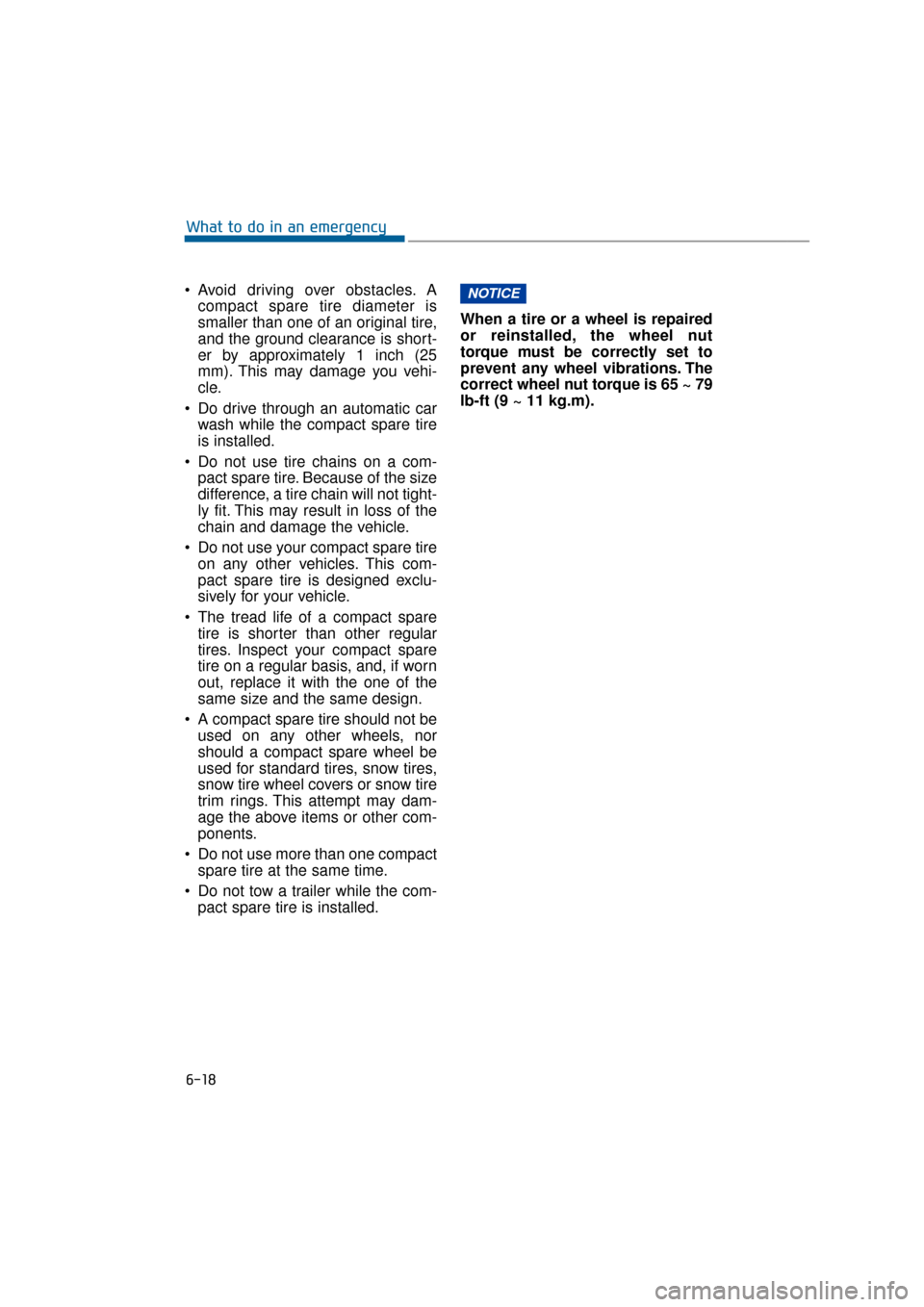
Avoid driving over obstacles. Acompact spare tire diameter is
smaller than one of an original tire,
and the ground clearance is short-
er by approximately 1 inch (25
mm). This may damage you vehi-
cle.
Do drive through an automatic car wash while the compact spare tire
is installed.
Do not use tire chains on a com- pact spare tire. Because of the size
difference, a tire chain will not tight-
ly fit. This may result in loss of the
chain and damage the vehicle.
Do not use your compact spare tire on any other vehicles. This com-
pact spare tire is designed exclu-
sively for your vehicle.
The tread life of a compact spare tire is shorter than other regular
tires. Inspect your compact spare
tire on a regular basis, and, if worn
out, replace it with the one of the
same size and the same design.
A compact spare tire should not be used on any other wheels, nor
should a compact spare wheel be
used for standard tires, snow tires,
snow tire wheel covers or snow tire
trim rings. This attempt may dam-
age the above items or other com-
ponents.
Do not use more than one compact spare tire at the same time.
Do not tow a trailer while the com- pact spare tire is installed. When a tire or a wheel is repaired
or reinstalled, the wheel nut
torque must be correctly set to
prevent any wheel vibrations. The
correct wheel nut torque is 65 ~ 79
lb-ft (9 ~ 11 kg.m).NOTICE
6-18
What to do in an emergency
Page 352 of 477
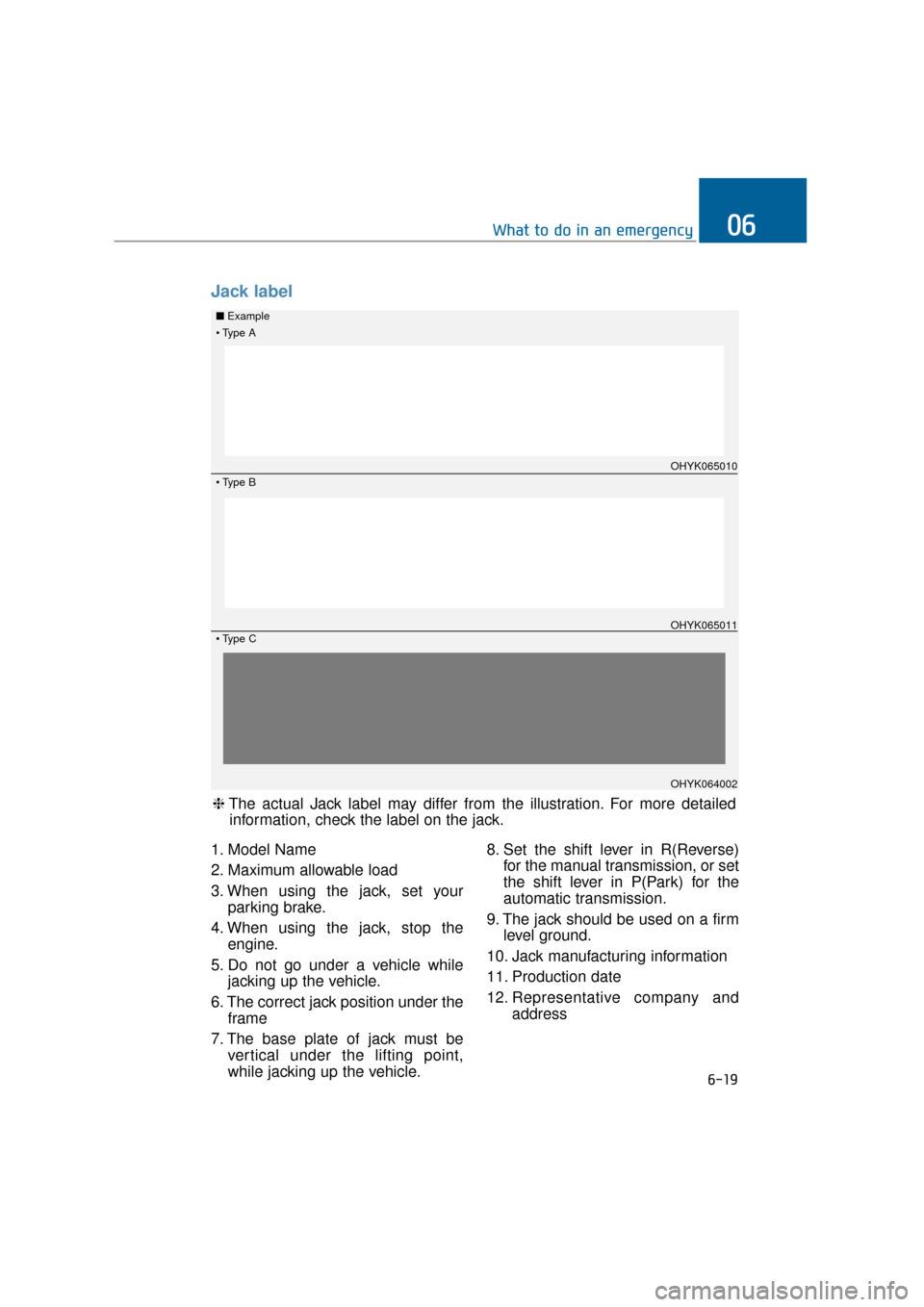
1. Model Name
2. Maximum allowable load
3. When using the jack, set yourparking brake.
4. When using the jack, stop the engine.
5. Do not go under a vehicle while jacking up the vehicle.
6. The correct jack position under the frame
7. The base plate of jack must be vertical under the lifting point,
while jacking up the vehicle. 8. Set the shift lever in R(Reverse)
for the manual transmission, or set
the shift lever in P(Park) for the
automatic transmission.
9. The jack should be used on a firm level ground.
10. Jack manufacturing information
11. Production date
12. Representative company and address
6-19
What to do in an emergency06
❈The actual Jack label may differ from the illustration. For more detailed
information, check the label on the jack.
Jack label
OHYK065010
■ Example
OHYK065011
OHYK064002
Page 353 of 477
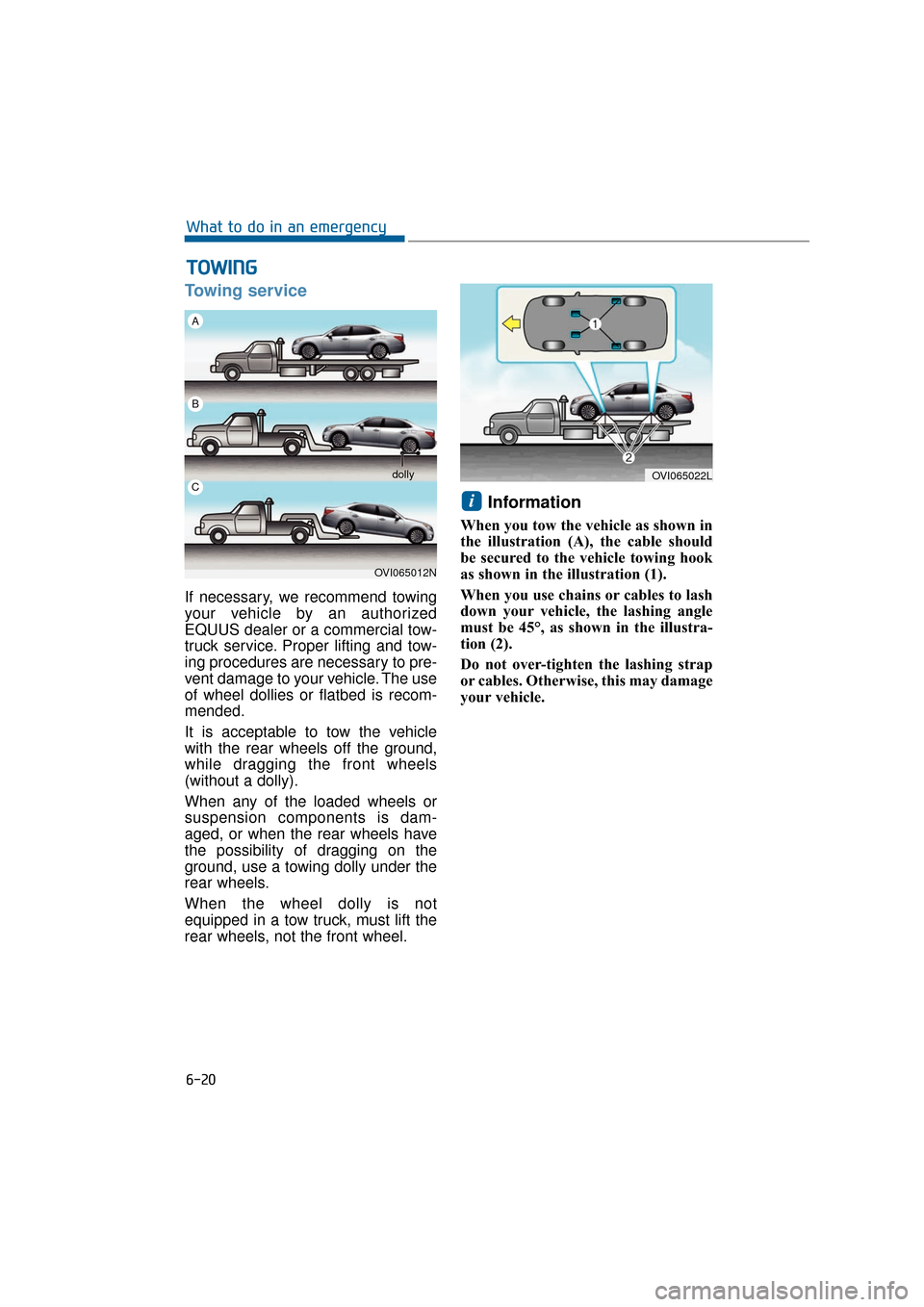
Towing service
If necessary, we recommend towing
your vehicle by an authorized
EQUUS dealer or a commercial tow-
truck service. Proper lifting and tow-
ing procedures are necessary to pre-
vent damage to your vehicle. The use
of wheel dollies or flatbed is recom-
mended.
It is acceptable to tow the vehicle
with the rear wheels off the ground,
while dragging the front wheels
(without a dolly).
When any of the loaded wheels or
suspension components is dam-
aged, or when the rear wheels have
the possibility of dragging on the
ground, use a towing dolly under the
rear wheels.
When the wheel dolly is not
equipped in a tow truck, must lift the
rear wheels, not the front wheel.
Information
When you tow the vehicle as shown in
the illustration (A), the cable should
be secured to the vehicle towing hook
as shown in the illustration (1).
When you use chains or cables to lash
down your vehicle, the lashing angle
must be 45°, as shown in the illustra-
tion (2).
Do not over-tighten the lashing strap
or cables. Otherwise, this may damage
your vehicle.
i
6-20
What to do in an emergency
T TO
O W
W I
IN
N G
G
OVI065012N
A
B
C dollyOVI065022L
Page 354 of 477
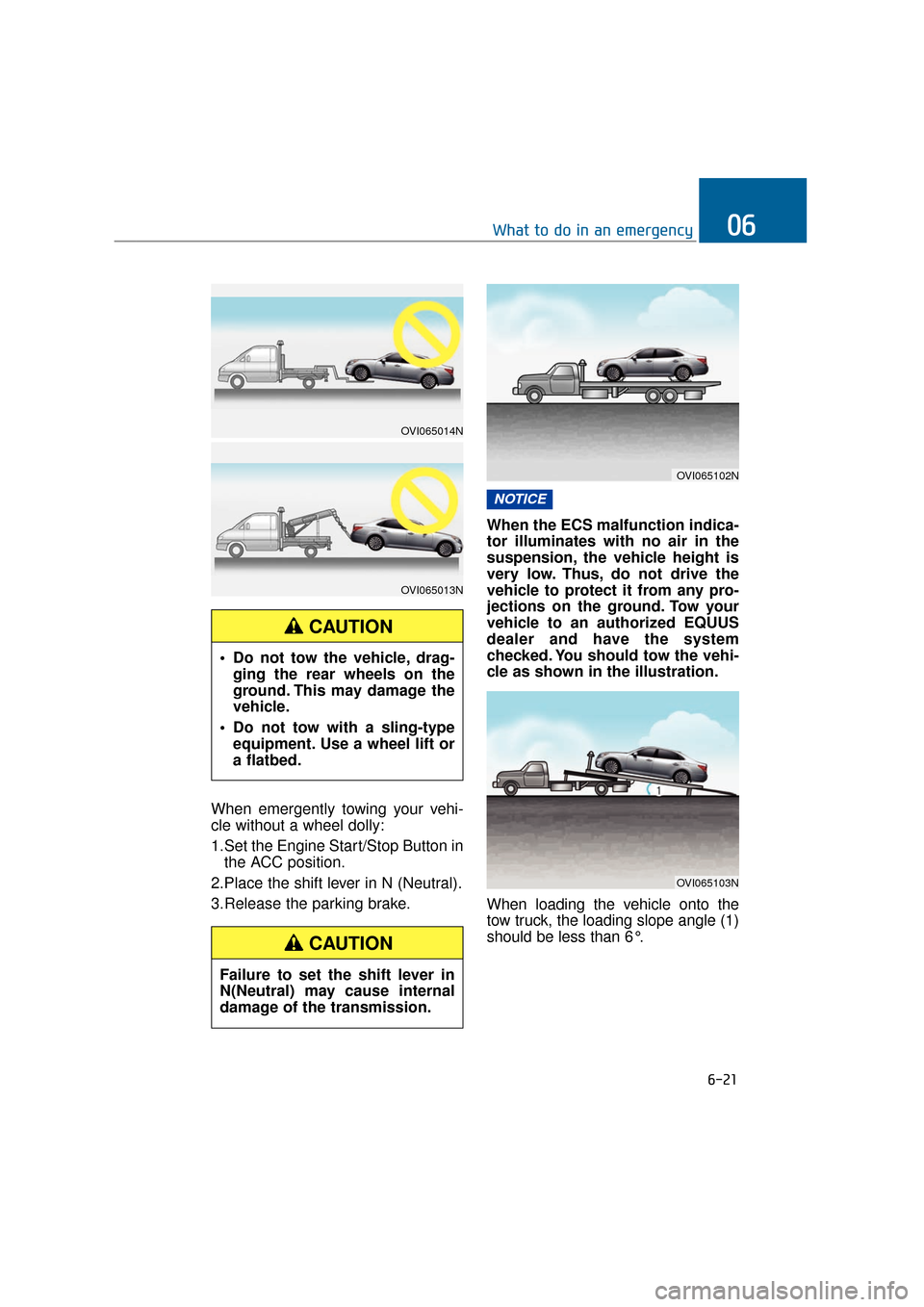
When emergently towing your vehi-
cle without a wheel dolly:
1.Set the Engine Start/Stop Button inthe ACC position.
2.Place the shift lever in N (Neutral).
3.Release the parking brake. When the ECS malfunction indica-
tor illuminates with no air in the
suspension, the vehicle height is
very low. Thus, do not drive the
vehicle to protect it from any pro-
jections on the ground. Tow your
vehicle to an authorized EQUUS
dealer and have the system
checked. You should tow the vehi-
cle as shown in the illustration.
When loading the vehicle onto the
tow truck, the loading slope angle (1)
should be less than 6°.
NOTICE
6-21
What to do in an emergency06
Do not tow the vehicle, drag-
ging the rear wheels on the
ground. This may damage the
vehicle.
Do not tow with a sling-type equipment. Use a wheel lift or
a flatbed.
CAUTION
Failure to set the shift lever in
N(Neutral) may cause internal
damage of the transmission.
CAUTION
OVI065102N
OVI065103N
OVI065014N
OVI065013N
Page 355 of 477
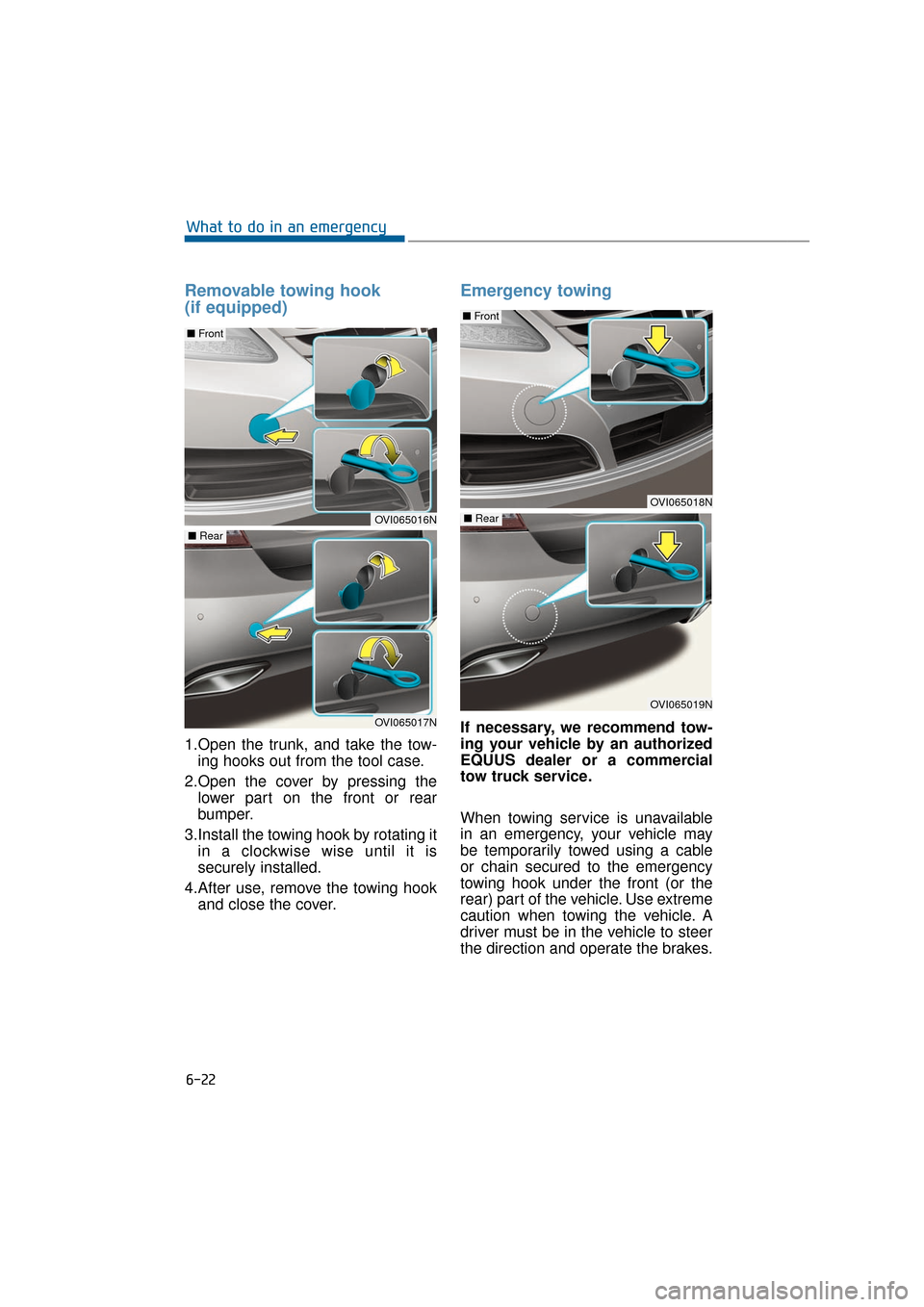
6-22
What to do in an emergency
Removable towing hook
(if equipped)
1.Open the trunk, and take the tow-ing hooks out from the tool case.
2.Open the cover by pressing the lower part on the front or rear
bumper.
3.Install the towing hook by rotating it in a clockwise wise until it is
securely installed.
4.After use, remove the towing hook and close the cover.
Emergency towing
If necessary, we recommend tow-
ing your vehicle by an authorized
EQUUS dealer or a commercial
tow truck service.
When towing service is unavailable
in an emergency, your vehicle may
be temporarily towed using a cable
or chain secured to the emergency
towing hook under the front (or the
rear) part of the vehicle. Use extreme
caution when towing the vehicle. A
driver must be in the vehicle to steer
the direction and operate the brakes.
OVI065018N
■ Front
OVI065019N
■ RearOVI065016N
■ Front
OVI065017N
■ Rear
Page 356 of 477
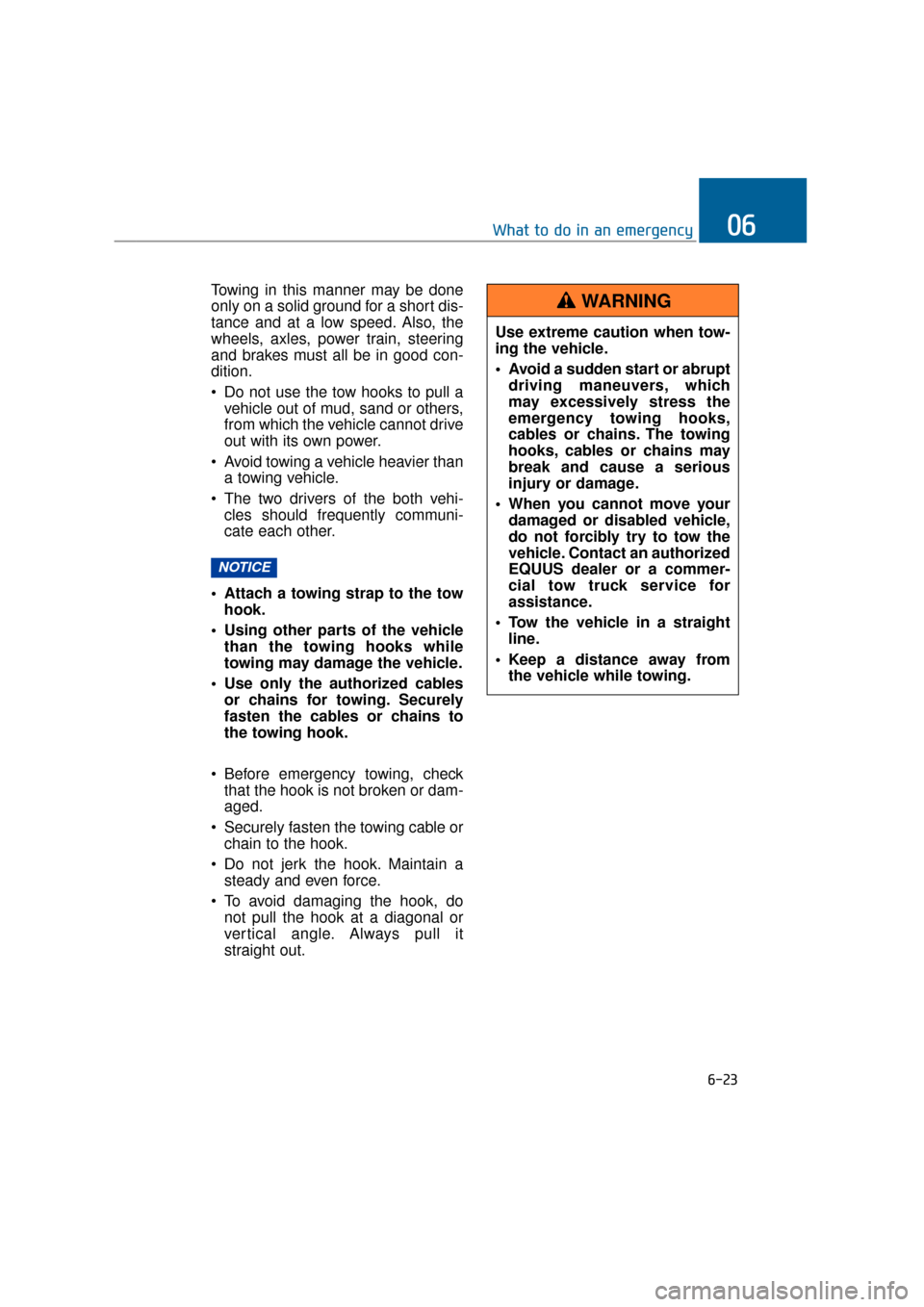
6-23
What to do in an emergency06
Towing in this manner may be done
only on a solid ground for a short dis-
tance and at a low speed. Also, the
wheels, axles, power train, steering
and brakes must all be in good con-
dition.
Do not use the tow hooks to pull avehicle out of mud, sand or others,
from which the vehicle cannot drive
out with its own power.
Avoid towing a vehicle heavier than a towing vehicle.
The two drivers of the both vehi- cles should frequently communi-
cate each other.
Attach a towing strap to the tow hook.
Using other parts of the vehicle than the towing hooks while
towing may damage the vehicle.
Use only the authorized cables or chains for towing. Securely
fasten the cables or chains to
the towing hook.
Before emergency towing, check that the hook is not broken or dam-
aged.
Securely fasten the towing cable or chain to the hook.
Do not jerk the hook. Maintain a steady and even force.
To avoid damaging the hook, do not pull the hook at a diagonal or
vertical angle. Always pull it
straight out.
NOTICE
Use extreme caution when tow-
ing the vehicle.
Avoid a sudden start or abruptdriving maneuvers, which
may excessively stress the
emergency towing hooks,
cables or chains. The towing
hooks, cables or chains may
break and cause a serious
injury or damage.
When you cannot move your damaged or disabled vehicle,
do not forcibly try to tow the
vehicle. Contact an authorized
EQUUS dealer or a commer-
cial tow truck service for
assistance.
Tow the vehicle in a straight line.
Keep a distance away from the vehicle while towing.
WARNING
Page 357 of 477
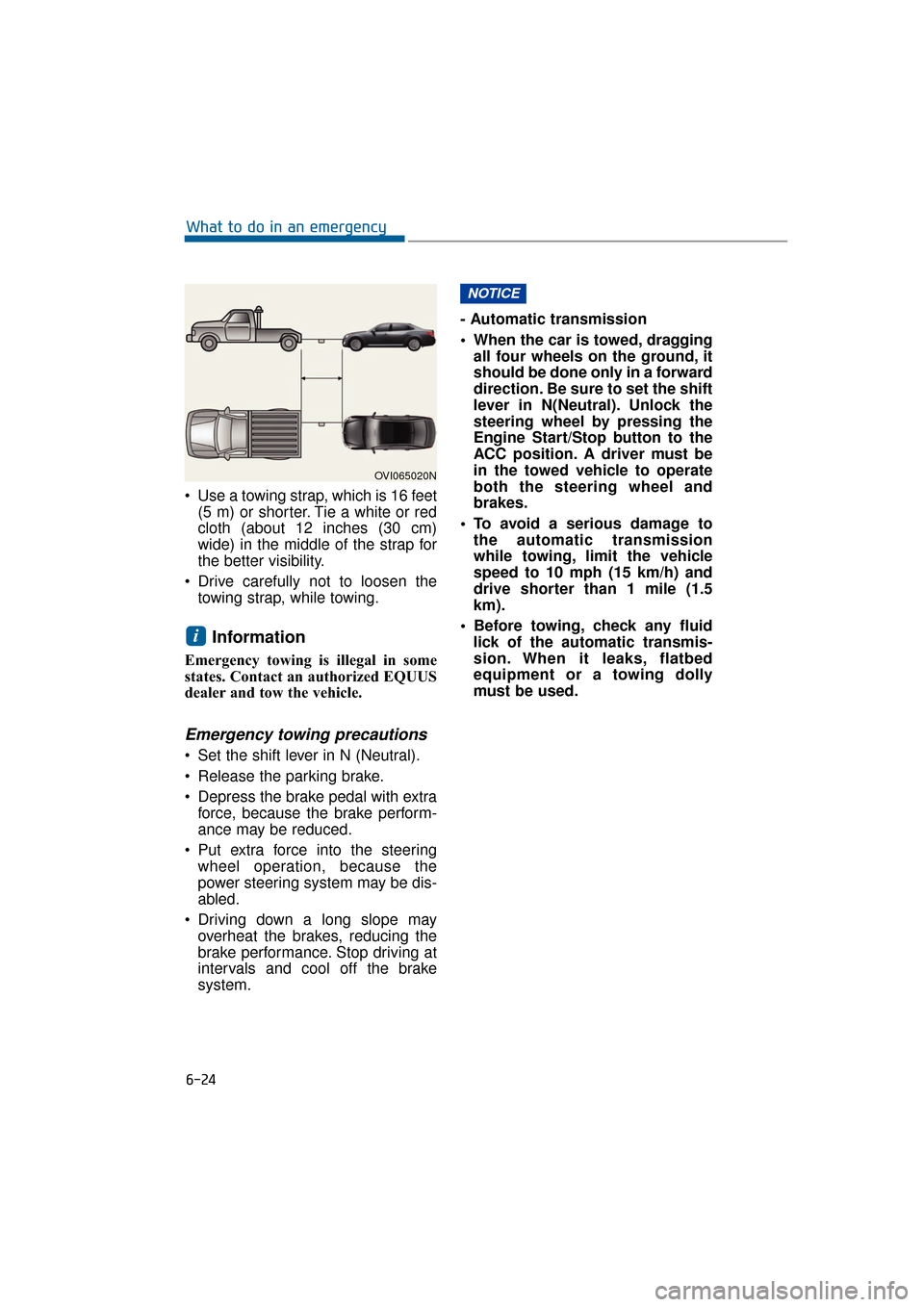
Use a towing strap, which is 16 feet(5 m) or shorter. Tie a white or red
cloth (about 12 inches (30 cm)
wide) in the middle of the strap for
the better visibility.
Drive carefully not to loosen the towing strap, while towing.
Information
Emergency towing is illegal in some
states. Contact an authorized EQUUS
dealer and tow the vehicle.
Emergency towing precautions
Set the shift lever in N (Neutral).
Release the parking brake.
Depress the brake pedal with extraforce, because the brake perform-
ance may be reduced.
Put extra force into the steering wheel operation, because the
power steering system may be dis-
abled.
Driving down a long slope may overheat the brakes, reducing the
brake performance. Stop driving at
intervals and cool off the brake
system. - Automatic transmission
When the car is towed, dragging
all four wheels on the ground, it
should be done only in a forward
direction. Be sure to set the shift
lever in N(Neutral). Unlock the
steering wheel by pressing the
Engine Start/Stop button to the
ACC position. A driver must be
in the towed vehicle to operate
both the steering wheel and
brakes.
To avoid a serious damage to the automatic transmission
while towing, limit the vehicle
speed to 10 mph (15 km/h) and
drive shorter than 1 mile (1.5
km).
Before towing, check any fluid lick of the automatic transmis-
sion. When it leaks, flatbed
equipment or a towing dolly
must be used.
NOTICE
i
6-24
What to do in an emergency
OVI065020N
Page 358 of 477
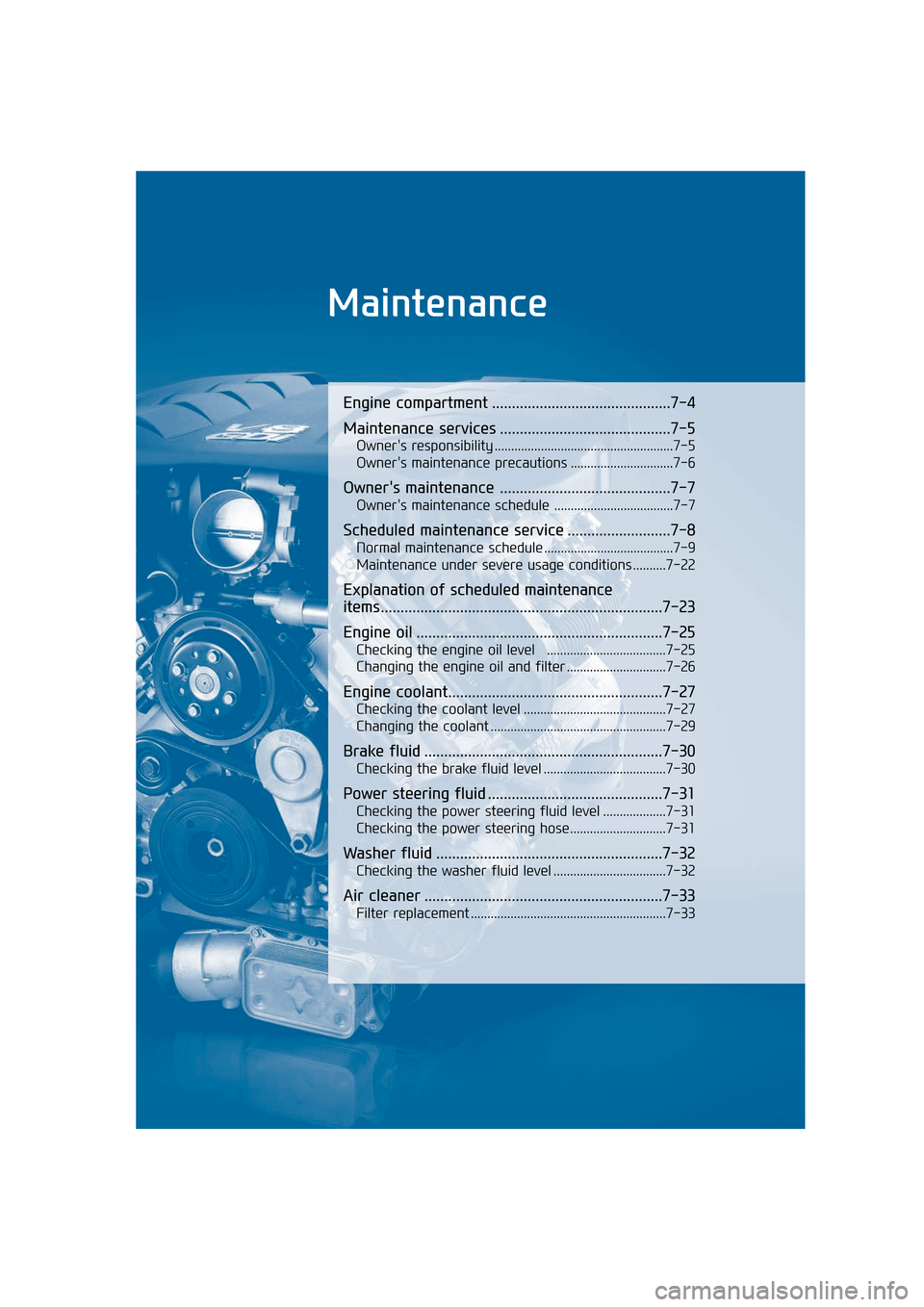
Maintenance
Engine compartment .............................................7-4
Maintenance services ...........................................7-5
Owner's responsibility ......................................................7-5
Owner's maintenance precautions ...............................7-6
Owner's maintenance ...........................................7-7
Owner's maintenance schedule ....................................7-7
Scheduled maintenance service ..........................7-8
Normal maintenance schedule .......................................7-9
Maintenance under severe usage conditions ..........7-22
Explanation of scheduled maintenance
items.......................................................................7\
-23
Engine oil ..............................................................7-25
Checking the engine oil level ....................................7-25
Changing the engine oil and filter ..............................7-26
Engine coolant......................................................7-27
Checking the coolant level ...........................................7-27
Changing the coolant .....................................................7-29
Brake fluid ............................................................7-30
Checking the brake fluid level .....................................7-30
Power steering fluid ............................................7-31
Checking the power steering fluid level ...................7-31
Checking the power steering hose.............................7-31
Washer fluid .........................................................7-32
Checking the washer fluid level ..................................7-32
Air cleaner ............................................................7-33
Filter replacement ...........................................................7-33
Page 359 of 477
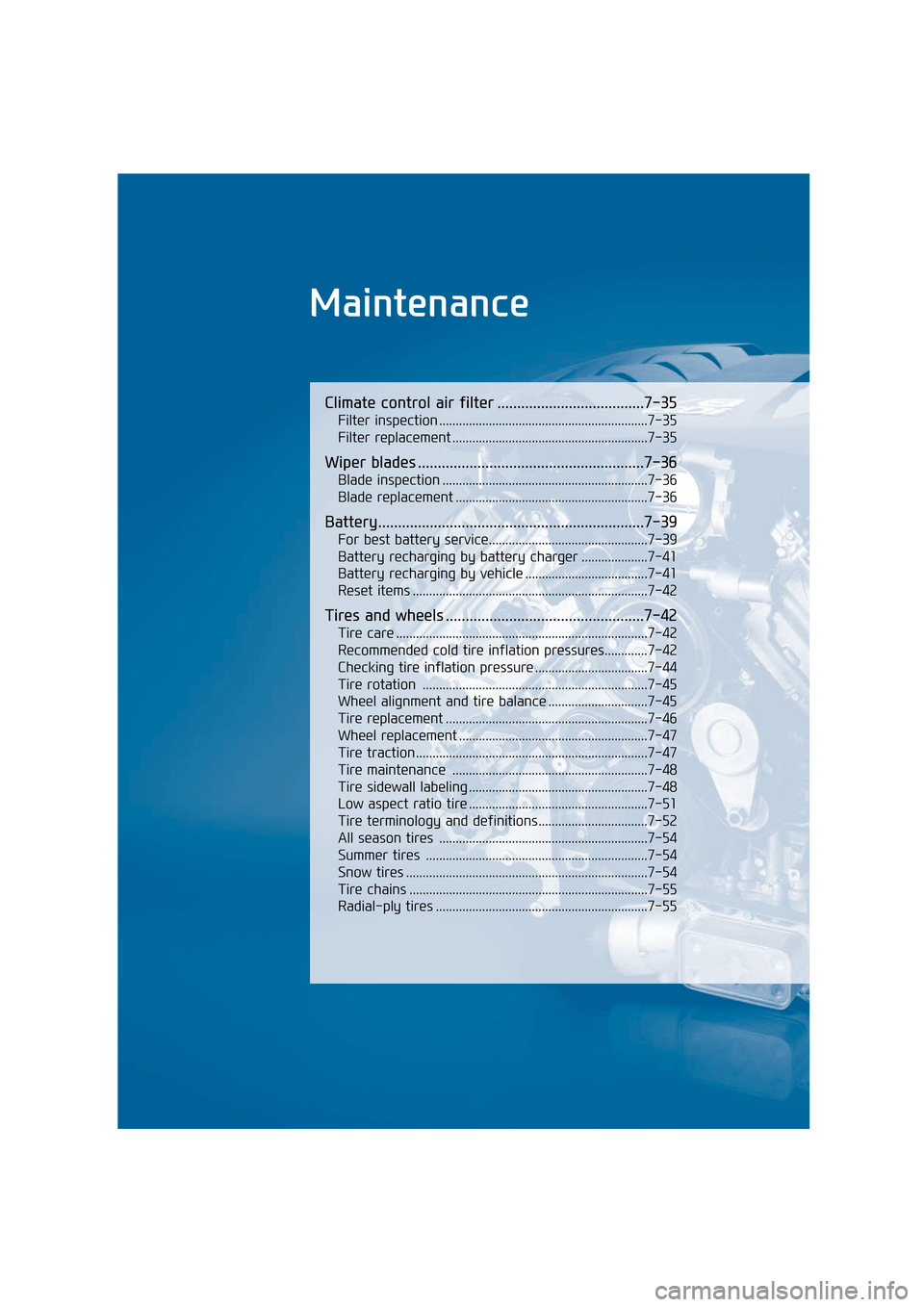
Maintenance
Climate control air filter .....................................7-35
Filter inspection ...............................................................7-35
Filter replacement ...........................................................7-35
Wiper blades .........................................................7-36
Blade inspection ..............................................................7-36
Blade replacement ..........................................................7-36
Battery...................................................................7-39
For best battery service................................................7-39
Battery recharging by battery charger ....................7-41
Battery recharging by vehicle .....................................7-41
Reset items .......................................................................7\
-42
Tires and wheels ..................................................7-42
Tire care ........................................................................\
....7-42
Recommended cold tire inflation pressures.............7-42
Checking tire inflation pressure ..................................7-44
Tire rotation ....................................................................7-45\
Wheel alignment and tire balance ..............................7-45
Tire replacement .............................................................7-46
Wheel replacement .........................................................7-47
Tire traction ......................................................................7-\
47
Tire maintenance ...........................................................7-48
Tire sidewall labeling ......................................................7-48
Low aspect ratio tire ......................................................7-51
Tire terminology and definitions.................................7-52
All season tires ...............................................................7-54
Summer tires ...................................................................7-54
Snow tires ........................................................................\
.7-54
Tire chains ........................................................................\
7-55
Radial-ply tires ................................................................7-55
Page 360 of 477
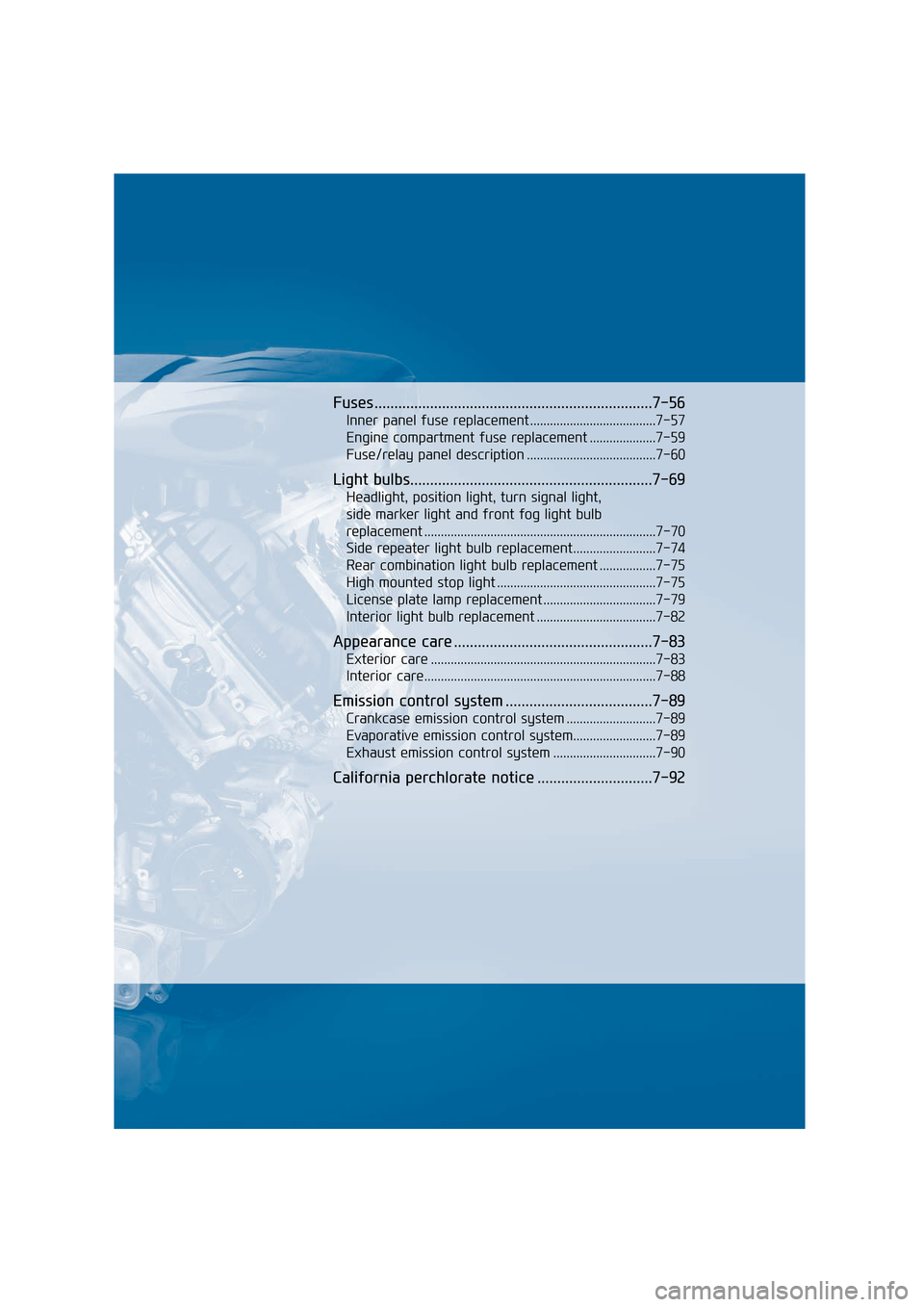
Fuses ......................................................................7-\
56
Inner panel fuse replacement ......................................7-57
Engine compartment fuse replacement ....................7-59
Fuse/relay panel description .......................................7-60
Light bulbs.............................................................7-69
Headlight, position light, turn signal light,
side marker light and front fog light bulb
replacement ......................................................................7-\
70
Side repeater light bulb replacement.........................7-74
Rear combination light bulb replacement .................7-75
High mounted stop light ................................................7-75
License plate lamp replacement ..................................7-79
Interior light bulb replacement ....................................7-82
Appearance care ..................................................7-83
Exterior care ....................................................................7-83\
Interior care......................................................................7-\
88
Emission control system .....................................7-89
Crankcase emission control system ...........................7-89
Evaporative emission control system.........................7-89
Exhaust emission control system ...............................7-90
California perchlorate notice .............................7-92